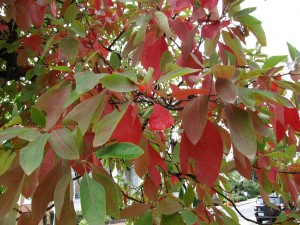A common woodland tree, sassafras (Sassafras albidum), aka mitten tree, is a small tree which grows 20 to 40 feet tall; some may top out at over 60 feet. Tree spread is two-thirds its height. Sassafras’ mitten shaped leaves, are easy to identify with one, two or no lobes. All three leaf shapes may be found on the same tree, as seen in the above photo.
This member of the laurel family, sassafras also has aromatic foliage. Tear apart a leaf or crush the stem; you’ll smell the famous sassafras scent. In colonial times sassafras roots and bark were important medicinal and cooking herbs. The leaves serve as larval food for swallowtail butterflies.
The tree prefers a sunny, moist, and well-drained site, and will tolerate light shade. Sassafras produces clusters of small yellow-green flowers in the spring before the leaves emerge. In late summer blue-black berries ripen, each on a red cup atop a crimson red stalk. Deer, birds and other wild fowl line up to quickly consume the fruits. Autumn leaf colors are quite variable, turning yellow, red, orange or purple.
Sassafras is vulnerable to wind or ice damage because the branches are brittle. Sassafras roots sucker prolifically and are pruned away as to not form plant colonies. When mature its reddish brown trunk is deeply furrowed.
Nurseries generally do not sell sassafras. Small container-grown plants may be purchased on-line. Sassafras has a deep fleshy taproot system and its transplant survival is low. You can also dig young plants from the wild (with owner’s permission).


 Posted in
Posted in 
